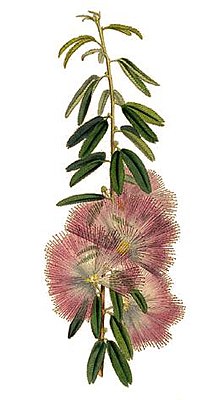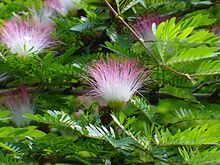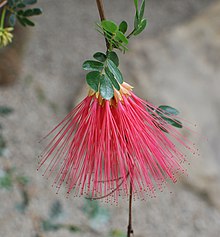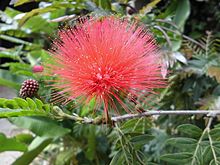Calliandra
| Calliandra | ||||||||||||
|---|---|---|---|---|---|---|---|---|---|---|---|---|

|
||||||||||||
| Systematics | ||||||||||||
|
||||||||||||
| Scientific name | ||||||||||||
| Calliandra | ||||||||||||
| Durazz. |
Calliandra is a genus in the subfamily of the mimosa plants (Mimosoideae) within the family of the Leguminosae (Fabaceae). The 150 to 200 species are mainly found in the Neotropics . Varieties of some species are used as ornamental plants , these types arecalled powder puff shrubs .
Description and ecology


Appearance and leaves
Calliandra species are deciduous shrubs or small trees . They usually have no thorns.
The alternate leaves arranged on the branches are divided into a petiole and a leaf blade. There are no glands on the leaves. The double-pinnate leaf blades consist of only one pair or a few pairs of pinnate of the first order. For each first-order leaflet there are only one pair to a few or many pairs of second-order leaflets arranged opposite one another . If there are many leaflets, they are small; if there are only a few, then they are relatively large. The mostly durable stipules are rarely converted to thorns; they are seldom completely absent.
Calliandra species have autonomous leaf movements due to turgor changes . These are circadian movements of the leaflets, also known as "sleep movements". These fold the individual feathers together in the day and night rhythm in the evening and open them again in the morning.
Inflorescences and flowers
The flowers stand together in lateral and head-shaped or terminal and racemose inflorescences .
The hermaphroditic flowers are rarely five, mostly six-fold with a double flower envelope . The mostly six sepals are fused bell-shaped with recognizable calyx teeth. The mostly six petals are fused funnel-shaped up to their middle. The flowers in the middle of the inflorescence sometimes have a longer corolla tube than the others. There are many (up to 100) stamens present. The white or red stamens are more or less long fused to form a staminal tube. The anthers are usually hairy glandular. The stamens are the most conspicuous part of the flower; they protrude clearly beyond the flower envelope. In each flower there is only one sitting carpel ; it contains many ovules . The stylus is thread-shaped.
The nectar-rich flowers attract butterflies and hummingbirds , for example .
Fruits and seeds
The stiff, leathery, flat, belt-shaped, somewhat sickle-shaped legumes often narrow towards the base and their edge is often thickened. The two fruit flaps open elastically from the upper towards the lower end. The obovate to spherical seeds are flattened. The seed coat (testa) is hard. There is no aril .
distribution
The genus Calliandra is distributed with 150 to 200 species mainly in the Neotropic from New Mexico to Chile . Six species occur in Costa Rica , one of them only there. There are eight species in Argentina and only one species in Chile. There are seven species in Cuba. Flora of China 2010 states that some species are native to India , Madagascar and Myanmar . Some species ( e.g. Calliandra houstoniana var. Calothyrsus , Calliandra haematocephala , Calliandra surinamensis ) are neophytes in the tropics and subtropics worldwide .
Systematics
The genus Calliandra was established in 1840 by George Bentham in Journal of Botany , in the second series of Botanical Miscellany , 2, 11, pp. 138-141. Type species is Calliandra houstonii (L'Hér.) Benth. Calliandra Benth. nom. cons. is conserved according to the guidelines of the ICBN (Vienna ICBN Art. 14.9 & App. III), because the type species was conserved. Synonyms for Calliandra Benth. are: Anneslia Salisb. , Codonandra H. Karst. The botanical genus name Calliandra is derived from the Greek words kalos for beautiful and andros for stamens, this refers to the beautiful flowers that are striking due to their stamens.
Robert C. Barneby divided the genus Calliandra in 1998 into five newly described sections and 14 series with only Neotropical species. The African and Asiatic species of this family group were transferred from Barneby to the genus Zapoteca H.M.Hern , which was previously purely Mexican . posed; however, this was not rated equally in some later publications. The scope of the genus Calliandra is controversial.
The genus Calliandra belongs to the tribe Ingeae in the subfamily Mimosoideae within the family Fabaceae .
The genus Calliandra contains 150 to 200 species:





- Calliandra aeschynomenoides Benth.
- Calliandra angustifolia Benth.
- Calliandra antioquiae Barneby
- Calliandra asplenioides (Nees) Renvoize
- Calliandra bahiana Renvoize
- Calliandra belizensis (Standl.) Standl.
- Calliandra bella (explos.) Benth. : It occurs only in the Brazilian state of Bahia.
- Calliandra biflora Tharp : It occurs only in Texas and in the northern Mexican state of Tamaulipas.
- Calliandra bijuga rose
- Calliandra blanchetii Benth.
- Calliandra bombycina Benth.
- Calliandra brenesii Standl.
- Calliandra brevicaulis Micheli
- Calliandra brevipes Benth.
- Calliandra caeciliae Harms
- Calliandra californica Benth. : It occurs only in the Mexican states of Baja Norte and Baja Sur.
- Calliandra calycina Benth.
- Calliandra carcerea Standl. & Steyerm.
- Calliandra Carrascana Barneby
- Calliandra chilensis Benth. : It occurs in Chile only in Atacama and Coquimbo.
- Calliandra chulumania Barneby
- Calliandra coccinea Renvoize
- Calliandra colimae Barneby
- Calliandra comosa (Sw.) Benth.
- Calliandra concinna Barneby
- Calliandra conferta Benth. : It occurs only in Texas and in the northern Mexican state of Coahuila.
- Calliandra coriacea (Willd.) Benth.
- Calliandra crassipes Benth.
- Calliandra cruegeri Griseb.
- Calliandra cumbucana Renvoize
- Calliandra cynometroides Bedd.
- Calliandra Debilis Renvoize
- Calliandra dendroidea Renvoize
- Calliandra depauperata Benth.
- Calliandra duckei Barneby
- Calliandra dysantha Benth.
- Calliandra elegans Renvoize
- Calliandra enervis (Britton) Urb.
- Calliandra eriophylla Benth. : It is common in the southern United States and Mexico.
- Calliandra erubescens Renvoize : It only occurs in the Brazilian state of Bahia.
- Calliandra erythrocephala H.M. Her. & M.Sousa
- Calliandra falcata Benth.
- Calliandra fasciculata Benth.
- Calliandra feioana Renvoize
- Calliandra fernandesii Barneby
- Calliandra foliolosa Benth.
- Calliandra fuscipila Harms
- Calliandra ganevii Barneby
- Calliandra gardneri Benth.
- Calliandra germana Barneby
- Calliandra gilbertii Thulin & Asfaw
- Calliandra glaziovii deaf.
- Calliandra glomerulata H. Karst.
- Calliandra glyphoxylon Benth.
- Calliandra goldmanii Barneby
- Calliandra grandifolia P.H. Allen
- Calliandra guildingii Benth.
-
Calliandra haematocephala Hassk. :
- Calliandra haematocephala var. Boliviana (Britton) Barneby (Syn .: Calliandra boliviana Britton )
- Calliandra haematocephala Hassk. var. haematocephala (Syn .: Calliandra inaequilatera Rusby , Calliandra novaesii Hoehne , Feuilleea haematocephala Kuntze ): It is native only in western Bolivia.
- Calliandra haematomma (DC.) Benth.
- Calliandra harrisii (Lindl.) Benth.
- Calliandra hintonii Barneby
- Calliandra hirsuta (G.Don) Benth.
- Calliandra hirsuticaulis Harms
- Calliandra hirtiflora Benth.
-
Calliandra houstoniana (Mill.) Standl. : With the varieties:
- Calliandra houstoniana var. Acapulcensis (Britton & Rose) Barneby
- Calliandra houstoniana var. Anomala (Kunth) Barneby (Syn .: Calliandra anomala (Kunth) JFMacbr. , Calliandra anomala var. Callistemon (Schltdl.) JFMacbr. , Calliandra callistemon (Schltdl.) Benth. , Calliandra conzattiana (Britton & Rose) Standl . , Calliandra grandiflora (L'Her.) Benth. , Calliandra grandiflora f. Pubesens Micheli , Calliandra kunthii Benth. , Calliandra leucothrix Standl. , Calliandra longipedicellata Macqueen & HMHern. ): It comes from northern Mexico via Guatemala to El Salvador and Honduras in front.
- Calliandra houstoniana var. Calothyrsus (Meissner) Barneby (Syn .: Calliandra calothyrsus Meissner , Calliandra confusa Sprague & L.Riley , Calliandra similis Sprague & L.Riley ): Your Central American natural home ranges from northern Mexico through Guatemala, Belize, Nicaragua and Panama . It is a neophyte in many areas around the world.
- Calliandra houstoniana var. Colomasensis (Britton & Rose) Barneby
- Calliandra houstoniana var. Houstoniana
- Calliandra humilis Benth.
- Calliandra hygrophila Mackinder & GPLewis
- Calliandra hymenaeodes (Pers.) Benth.
- Calliandra iligna Barneby
- Calliandra imperialis Barneby
- Calliandra involuta Mackinder & GPLewis
- Calliandra jariensis Barneby
- Calliandra juzepczukii Standl.
- Calliandra kuhlmannii Hoehne
- Calliandra laevis rose
- Calliandra lanata Benth.
- Calliandra laxa (Willd.) Benth.
- Calliandra leptopoda Benth.
- Calliandra linearis Benth.
- Calliandra lintea Barneby
- Calliandra longipes Benth.
- Calliandra longipinna Benth.
- Calliandra Luetzelburgii Harms
- Calliandra macqqueenii Barneby
- Calliandra macrocalyx Harms
- Calliandra magdalenae (DC.) Benth.
- Calliandra medellinensis Britton & Killip
- Calliandra molinae Standl.
- Calliandra mollissima (Willd.) Benth.
- Calliandra mucugeana Renvoize
- Calliandra myriophylla Benth.
- Calliandra nebulosa Barneby
- Calliandra pakaraimensis Cowan
- Calliandra Palmeri S. Watson
- Calliandra paniculata C.D. Adams
- Calliandra parviflora Benth.
- Calliandra parvifolia (Hook. & Arn.) Speg.
- Calliandra paterna Barneby
- Calliandra pauciflora (A.Rich.) Griseb.
- Calliandra pedicellata Benth.
- Calliandra peninsularis Rose : It occurs only in the Mexican state of Baja Sur.
- Calliandra physocalyx H.M.Hern. & M.Sousa
- Calliandra pilgerana Harms
- Calliandra pilosa (DC.) Urb.
- Calliandra Pittieri Standl.
- Calliandra pityophylla Barneby
- Calliandra pubens Renvoize
- Calliandra purdiaei Benth.
- Calliandra purpurea (L.) Benth.
- Calliandra quetzal ( Thu.Sm. ) Thu.Sm.
- Calliandra redacta (JHRoss) Thulin & Asfaw
- Calliandra renvoizeana Barneby
- Calliandra rhodocephala Donn.Sm.
- Calliandra rigida Benth.
- Calliandra riparia Pittier
- Calliandra rubescens (M.Martens & Galeotti) Standl.
- Calliandra Samik Barneby
- Calliandra Santosiana Barneby
- Calliandra Seleri Harms
- Calliandra semisepulta Barneby
- Calliandra sesquipedalis McVaugh
- Calliandra sessilis Benth.
- Calliandra silvicola deaf.
- Calliandra sincorana Harms
- Calliandra spinosa Ducke
- Calliandra squarrosa Benth.
- Calliandra staminea (Thunb.) Barneby
- Calliandra stelligera Barneby
- Calliandra stipulacea Benth.
- Calliandra subspicata Benth.
- Calliandra surinamensis Benth. (Syn .: Calliandra angustidens Britton & Killip , Calliandra tenuiflora Benth. )
- Calliandra taxifolia (Kunth) Benth.
-
Calliandra tergemina (L.) Benth. : With the varieties:
- Calliandra tergemina var. Emarginata (Willd.) Barneby (Syn .: Calliandra canescens Benth. , Calliandra cruziana Standl. , Calliandra deamii (Britton & Rose) Standl. , Calliandra emarginata (Willd.) Benth. , Calliandra langlassei Harms , Calliandra mexicana Brandegee , Calliandra purpusii Brandegee , Calliandra rupestris Brandegee , Calliandra seemannii Seem. , Calliandra sinaloana Standl. , Calliandra tetraphylla (G.Don) Benth. , Calliandra tolimensis Uribe , Calliandra uribei Killip & Dugand , Rose Calliandra yucatanensis . ) & Brittlonensis. )
- Calliandra tergemina var. Tergemina
- Calliandra tolimensis Deaf.
- Calliandra trinervia Benth.
- Calliandra tsugoides Cowan
- Calliandra tumbeziana J.F. Macbr.
- Brazilian powder puff bush, Schönmännchen ( Calliandra tweedii Benth. )
- Calliandra Ulei Harms
- Calliandra umbellifera Benth.
- Calliandra umbrosa (Wall.) Benth.
- Calliandra ungulata (Desv.) Benth. ex Jackson
- Calliandra Urbanii Alain
- Calliandra vaupesiana Cowan
- Calliandra virgata Benth.
- Calliandra viscidula Benth.
- Calliandra wendlandii Benth.
use
Varieties of some species are used as ornamental trees in the frost-free areas. For example Calliandra californica , Calliandra eriophylla , Calliandra houstoniana var. Anomala , Calliandra haematocephala , Calliandra surinamensis , Calliandra tergemina var. Emarginata , Calliandra tweedii . They are also suitable as container plants or in winter gardens as ornamental plants .
ingredients
Depending on the species, the leaves contain considerable amounts of pipecolic acid and free proline . The seeds contain free sulfur-containing amino acid ; it can also be detected in seedlings. There are saponins present. Hydroxypipecolic acid has an insecticidal and feeding repellant effect on phytophagous insects.
swell
- Delin Wu & Ivan C. Nielsen: Ingeae. : Calliandra. P. 60 - same text online as printed work In: Wu Zheng-yi, Peter H. Raven & Deyuan Hong (eds.): Flora of China. Volume 10: Fabaceae. Science Press and Missouri Botanical Garden Press, Beijing and St. Louis, 2010. ISBN 978-1-930723-91-7 (Description and Distribution Sections)
- Syed Irtifaq Ali: Calliandra. In: Flora of West Pakistan 36: Mimosaceae. Stewart Herbarium, Rawalpindi 1973.
- Robert C. Barneby: Silk tree, guanacaste, monkey's earring: a generic system for the synandrous Mimosaceae of the Americas. Part III. Calliandra. In: Memoirs of the New York Botanical Garden. Volume 74, Number 3, 1998, pp. 1-223. (Sections Systematics and Distribution)
Individual evidence
- ↑ Martin Bäßler: The genus Calliandra Benth. (Leguminosae, Mimosoideae) in Cuba , In: Gleditschia , Volume 18, 2, 1990, pp. 187-210.
- ↑ Species list at Pacific Island Ecosystems at Risk = PIER.
- ↑ First publication scanned at biodiversitylibrary.org .
- ^ Calliandra at Tropicos.org. Missouri Botanical Garden, St. Louis
- ^ A b Calliandra in the Germplasm Resources Information Network (GRIN), USDA , ARS , National Genetic Resources Program. National Germplasm Resources Laboratory, Beltsville, Maryland.
- ↑ Enter Calliandra in the search mask at LegumeWeb - International Legume Database & Information Service = ILDIS, Version 9.00, January 2005.
- ↑ Gordon Cheers (Ed.): Botanica: The ABC of plants. 10,000 species in text and images . Könemann Verlagsgesellschaft, 2003, ISBN 3-8331-1600-5 ( Calliandra on p. 168).
- ^ Robert Hegnauer: Caesalpinioideae and Mimosoideae , Volume 1, Part 2 - Volume 11 by Robert Hegnauer: Chemotaxonomie der Pflanzen , Leguminosae. XI , textbooks and monographs from the field of exact sciences. Chemical series , 1996. ISBN 978-3-7643-5165-6 Google-Books-Online. Calliandra pp. 360-361
Web links
further reading
- SA Renvoize: The Genus Calliandra (Leguminosae) in Bahia, Brazil , In: Kew Bulletin , Volume 36, Issue 1, 1981, pp. 63-83.













